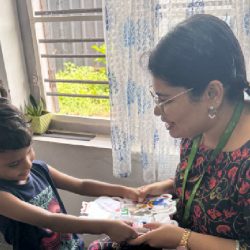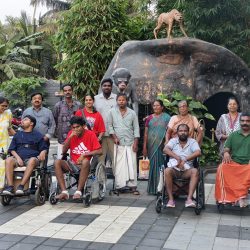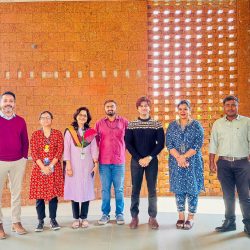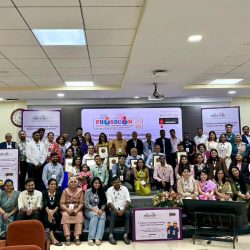October 2010
The Rain Gods Helped Us!
Our celebrations for World Palliative Care Day on 9th October 2010 in Trivandrum were a phenomenal success. It was raining cats and dogs for several days – very unusual for this time of the year – and all the weather pundits were predicting continued rain! But, the sky cleared by noon and rain kept off until midnight, giving us lovely weather for the program.
The musicians also gave their best. “Old is Gold“, the troupe led by Padmasree Udayabhanu, included such noted singers as Suseela Devi.P, Srikanth.N, Arundhathi, Kallara Gopan, Bhavana Radhakrishnan, Preetha P.V, Radhakrishnan, Sriram, Ravisankar, Rakesh Brahmanandan and Kavalam Srikumar – all of whom gave their services free. [click here for pictures]
There were several luminaries from the literary and public fields at the program (including the famous poet and environmentalist, Smt Sugathakumari), but the real dignitaries were our patients for whom the musicians performed.
The lilting melodies from the past melted every heart. One of the performers was our own young volunteer, Sarat! The program was jointly organized by Pallium India and Rajeswari Foundation.
The organizing team led by our volunteer Brigadier Oommen John deserve congratulations!
Volunteers Recognized
One of the highlights of the World Palliative Care Day celebrations was the recognition given to two of our volunteers: Sri K Sivadasan who is the chief organizer of Nanniyode Palliative Care Centre and the other Mrs Patricia Paul Fernandez (fondly called Lijo by everyone) who provides exemplary care to patients at Murukkumpuzha.
Mr. Sivadasan and Mrs Lijo, we are proud of you!
–
World Palliative Care Day in Srinagar
Dr Yousuf Tak from Srinagar writes,
It is a really tough time Kashmir is going through at the moment.
But, we managed to organise a seminar on the eve of World Hospice and Palliative Care Day in the lawns of Pulwama District Hospital to raise awareness on the subject.”
Most of us living in safe zones in the world cannot even begin to understand the struggle of people like Yousuf Tak in Kashmir.
Kudos to you, Yousuf. You still manage to do your bit despite all the difficulties!
–
Pallium India-USA Launched in California!
Initiated by Dr Jerina Kapoor (Founder & President), Pallium India-USA will work towards improving access to palliative care in India, but will also provide information to the Indian community in USA on matters relating to Advanced Care Directives and available services for their relatives back in India.
At a function held on September 26th, 2010 in the India Community Center, Milpitas, California, Dr Vyjeyanthi Periyakoil from Stanford University, Dr M.R. Rajagopal (Chairman, Pallium India), Ms Sandy Stokes from the Chinese American Coalition for Compassionate Care and Dr Jerina Kapoor addressed a gathering of more than 130 members, the vast majority of them from the Indian community.
The theme of the meeting can be summarized as answering the questions:
God forbid that something like that should happen to you, but…
- If a relative of yours has incurable cancer in India, where can that person access pain management or palliative care?
- How can you ensure that the person lives with dignity during the last few months of his life?
- What can you do to improve access to people like him?
Or, if you get an advanced incurable disease… Where would you like to spend your last few weeks or days? In an intensive care unit or in your home? How can you ensure that your wishes are respected?
The attendees took a general decision to support initiation of palliative care services in as many places in India as possible and decided on an action plan for the same.
For the USA based population, Advanced Care Directives was recommended, as a way to have a say in the care that people would receive in case they are not able to speak for them selves because of an illness.
Also, decision was taken to form Speaker Forums to go out in the community to talk about end-of -life issues, and there were many people volunteering for that. People expressed interest in looking at the resources in their home towns in India for palliative care and work to improve that. So, it was a meeting that inspired people to work to improve things in their own community, whether here in the US or in India.

There was a ‘can do’ spirit in the room. A decision was taken to have a follow up meeting to organize ourselves.
India West Reports on Pallium India-USA
The recent Pallium India-USA launch has been reported in India West, the “USA’s Most Honored Indian Newspaper Published From California”. View and download the report…
–
Another step forward for Project Hamrahi
Project Hamrahi is a mentoring program for Indian palliative care programs jointly initiated by Australia Palliative Link International and Pallium India. Its pioneer, Dr Odette Spruyt was the first person to make a visit for this purpose to Patna in Bihar earlier this year. Odette has subsequently been following up with Patna.
The second visit under the project happened this month (October 2010) at Thiruvalla, a town in Kerala about 130 kilometres north of Trivandrum. In a prestigious medical school and hospital (Pushpagiri), Dr P.T.Thampi started a palliative care program five years back. He works with a dedicated team of volunteers and staff.
Dr Sok-Hui Goh from project Hamrahi spent a week with the team recently, walking with the team on home visits, seeing patients, discussing problems and solutions, and conducting educational programs. Her husband Dr.Andrew Chew taught surgery residents. Sok-Hui and Andrew hope to continue their friendship with the Thiruvalla team.
Thank you Sok and Andrew.
–
Love Really is Like a Drug
The Guardian reports on a Stanford University School of Medicine study which finds that love not only blocks pain, it also seems to stimulate the same parts of the brain as morphine:
Intense spells of passion are as effective at blocking pain as cocaine and other illicit drugs, a team of neuroscientists say. Tests on 15 American students who admitted to being in the passionate early stages of a relationship showed that feelings for their partner reduced intense pain by 12% and moderate pain by 45%.
In the study, researchers at Stanford University showed eight women and seven men photographs of their partners while delivering mild doses of pain to their palms with a hot probe. At the same time, the students had their brains scanned by a functional magnetic resonance imaging machine. At the end of each test, the students were asked to rate how much pain they felt.
Feelings of love, triggered by a photo of their partner, acted as a powerful painkiller. Brain scans revealed that these feelings caused more activity in parts of the brain that are also triggered by morphine and cocaine. Looking at an image of an attractive friend rather than their partner had only a mild analgesic effect.
Read more at The Guardian…
Download the study from Plosone.org: Viewing Pictures of a Romantic Partner Reduces Experimental Pain: Involvement of Neural Reward Systems [pdf]
–
Care and Share
Care and Share is an American non-profit organization created in 1990 by a handful of professionals based in USA. They have been staunch supporters of Pallium India’s palliative care efforts.
Youtube: Brief description of Care and Share’s activities, in particular their “Ganolsavam 2009” – Ganolsavam 2010 was held on October 9th…
–
Reader’s Digest: A Good End
There is a fantastic article on Palliative Care and End-of-Life issues in the October 2010 issue of Reader’s Digest Australia by Helen Signy:
A Good End
Each year half a million Australians experience the impact of a terminal illness as patients, carers or family members – yet talking about dying is not something that comes naturally to the majority of us.
Facing up to death is difficult, but for the individual who knows his or her life is drawing to a close, being able to communicate openly and honestly with family and friends is often of immeasurable comfort.
“For terminally ill people it’s a very lonely, isolated experience because no-one else really can know what it’s like to know that time is limited,” says Suzanne Clementi, a counsellor at Brisbane’s Karuna Hospice Service, which offers home-based palliative care. “Everyone tries to protect themselves by not talking about it. Often I find it’s the people who are more honest and talk about it openly who are the ones who cope better.”
Medical intervention can often control pain, yet the lack of awareness about how to die well that troubles health advocates.
Palliative Care Australia CEO Donna Daniell says many Australians are unsure what to expect at the end of their lives: they don’t know where to find support, and they fail to plan in advance. “We need to get the conversation going so we can work towards a better death,” she says.
Here, four people who are facing death talk about their experiences:
–
Focus on Palliative Care in Developing Countries
 Nancy Hinds is a palliative care pioneer in Fresno, California. She founded the Hinds Hospice which leads palliative care delivery in the region.
Nancy Hinds is a palliative care pioneer in Fresno, California. She founded the Hinds Hospice which leads palliative care delivery in the region.
It would have been easy for Nancy to do the job in Fresno and to be satisfied with that. But she chose to look beyond her territory and to look at suffering elsewhere. Last month saw her leading a conference, “Hospice and Palliative Care in the Global Community“, which focused on palliative care in developing countries.
Participants from developed and developing countries worked together to share experiences and to develop an action plan for future action.
Nancy’s gang, as the group was fondly nicknamed at the conference, is set to go places. Thank you Nancy and gang, for all that you have set out to do.
–
A Child In Pain… A Mother’s Suffering
For those who attended the palliative care conference in Fresno last month, it was indeed a powerful experience to listen to a talk by Dianne Gray from the Elisabeth Kübler Ross Foundation.
She talked about how her son was diagnosed with an incurable progressive neurological disease at the age of four, how the family’s lack of communication destroyed her marriage and changed her whole life, how her child suffered because her son’s pediatric sub-specialists were misinformed on the topic of hospice/palliative care and fearful of giving the child morphine.
Eventually, when a palliative care team got involved and gave the child morphine, life became a bit more bearable for the family. But towards the end, he went into intense muscle spasms and agonizing pain. He suffered for 8 days without getting pain relief, or if that was not a possibility, palliative sedation.
A lack of education and communication left the family and some care providers involved feeling inept and saddened by the persistent suffering as they knew this did not need to be the case.
Dianne’s talk was at a conference for developing countries. It left the audience feeling anger at the fact that these things were permitted to happen in a developed country where such practices would not be expected.
Some problems seem to be common to the whole World, developed or not.
–
We all love children, right? Yet we are so cruel to them.
When a child is in agonizing pain, if you have the means at your disposal to relieve that pain safely, yet refuse to use them, is that not tantamount to torture?!
If you think the following story from Kenya is not relevant to India or to the rest of the developing world, sorry, you are mistaken.
Here are a couple of quotes from the British Medical Journal article “Restrictive government policies leave Kenyan children dying in pain” (BMJ 2010; 341:c4864 doi: 10.1136/bmj.c4864, 9/9/10):
One doctor treating children with cancer in Nairobi told researchers, “People have no problems with relieving pain in adults with morphine, but when it comes to children there is always some reservation. Putting a child on morphine is always a big issue.”
and,
A nurse from Bondo district hospital said, “We have no pethidine, no DF118 [dihydrocodeine], and no morphine. We have children here with advanced HIV; some are in severe pain. The pain management for children with advanced HIV is not enough.”
The BMJ article refers to a 78-page report by Human Rights Watch “Needless Pain: Government Failure to Provide Palliative Care for Children in Kenya”.
You can read the complete HRW report online or download a PDF
Accompanying the report, HRW has two powerful videos from Kenya telling the story of Jethro and Sammy, WATCH them here…
–
Malaysia’s Pain Management Guidelines
 Dr Richard Lim from Malaysia writes to introduce their new Evidence Based Clinical Practice Guideline on Cancer Pain Management in Malaysia.
Dr Richard Lim from Malaysia writes to introduce their new Evidence Based Clinical Practice Guideline on Cancer Pain Management in Malaysia.
A large official launch by the Ministry of Health will take place sometime in December or January. They are also preparing a training module and will be starting a series of roadshows to promote this guideline.
You can download the Guidelines from the MOH website:
- Clinical Practice Guidelines – in full (PDF)
- Quick Reference for Healthcare Providers (PDF)
Dr Lim continues to write that it took them a good 2 years to get it all done and hopes that it will serve as a useful reference for all healthcare workers in Malaysia managing patients with cancer.
Having scanned through the document, we find it to be an excellent resource for India too. True, some of their drugs are not available in India, and they do not seem to have some low cost drugs that we use over here; but by and large, it will be a useful addition to the armamentarium for palliative care institutions in India.
And please make note of another important hidden message in Dr Lim’s email – his efforts do not stop with the publication of the guidelines – they are going on to a “public launch” and “road shows“.
Unless the guidelines reach the consumers, what is the use? A lesson to learn there, is there not?
–
Mind-Body Medicine
Mrs. X was in tears. Her husband has gone through three cancers: a non-Hogdkin’s lymphoma, then a Hodgkins lymphoma and finally a malignant melanoma.
She herself has just gone through colonic surgery – and she has three children to take care of.
“Is this suffering any less than the suffering from incurable diseases in India?”, Dr. Amit Sood asks.
Dr Amit Sood heads the department of Integrative Medicine at the famous Mayo Clinic in Rochester, Minnesota, USA.
The department undertakes serious research in Mind-Body Medicine and studies various complementary and alternative medicine (CAM) forms of therapy.
Amit says that meditation and acupuncture are the CAM modalities best supported by evidence. With the meditation training the department provides, Mrs. X is able to cope with her situation.

Amit runs a course at Mayo on Mind-Body Medicine and has published a book called “Train your mind, Engage your heart, Transform your life.”.
We hope to work with Amit to adapt his techniques so that they can be put to good use in India.
–
Pain in Africa
Kathy Kreiter, the executive director of International Association for Study of Pain (IASP) brings our attention to another report from the Economist, Pain in Africa:
Drugs in Africa: A lot of pain
Africans need more morphine
GERARD was five years old when he died this year of AIDS. He lived in a slum in the Kenyan capital, Nairobi, and was nursed by his mother. “I could tell he was in a lot of pain,” she says. Yet Gerard received no relief except for ibuprofen, a mild painkiller.
…
The International Narcotics Control Board, a UN body that oversees controlled drugs, says 90% of the world’s morphine is administered in rich countries. By contrast, morphine and other painkillers such as pethidine and dihydrocodeine are hard to find in state systems in poor countries. So Africans with AIDS, cancer, sickle-cell disease, victims of car crashes, gunshot and machete wounds, and women in labour, suffer severe pain without relief.
Kenya is ahead of many African countries in palliative care, with its own hospice movement, but only seven of its 250 hospitals have ready access to morphine. Even when it is in stock, the annual supply is limited to some 1,500 patients. Yet 180,000 Kenyans die each year of AIDS and cancer alone. A 75mg daily dose of morphine would make all the difference.
Read the full article on The Economist website…
Not that there is any new information there; but every little bit of attention to the pain problem in the media helps the cause.
–
Rural MBBS Degree in India
 India has come out with a “Rural MBBS” program in which the course duration has been shortened from the conventional six years and a half (including house surgeoncy) to four years.
India has come out with a “Rural MBBS” program in which the course duration has been shortened from the conventional six years and a half (including house surgeoncy) to four years.
These doctors will have training with no frills. Their training will not include exotic surgery or too detailed basic sciences, but will be problem oriented training in ordinary ailments. They will have to sign an agreement by which they will have to practice in a rural area for a minimum of ten years.
There has been considerable debate about this new program and the medical fraternity has been generally against it. In a recent article in The Lancet entitled “Rural MBBS degree in India”, the authors Sanjay Kinra and Yoav Ben-Schlomo point out how poor the medical service in rural India is, and raise a couple of issues.
One simple question is:
- Do we know it for a fact that the current six and a half years is the optimal period of training for a doctor?
- On the other hand, are the rural and smaller hospitals competent to train these doctors?
Full text with references can be viewed on TheLancet.com (free registration required)
–
18th International Conference of Indian Association of Palliative Care
Dr Piyush Gupta, organizing secretary, invites you to the 18th International Conference of Indian Association of Palliative Care at Lucknow – the historic City of Nawabs having rich cultural heritage. To be held from February 11th to 13th, 2011 (Friday – Sunday) at Sanjay Gandhi Post Graduate Institute of Medical Sciences.
Full details at the 18th International Conference of Indian Association of Palliative Care website…
–
PARTING SHOT… On Hope…
A Pallium India blog on Hope (https://palliumindia.org/2010/10/hospice-care-and-hope/) made one of our readers ask, “What hope can remain in someone who knows he has only weeks to die?”
The answer could be in a quotation from Martin Luther King Jr,
“We must accept finite disappointment, but we must never lose infinite hope”.
As carers, we sometimes need to help people to bring hopes down to realistic levels. The person’s hope may not be sustainable if he wants cure and nothing but cure, but may be achievable if his hope is to see his daughter married or if he just wants to go to his favourite temple one last time.
Such a change cannot be forced; it will have to be achieved by listening to him, helping him to ventilate feelings and in short “walking with him” till he reaches the desired state of mind.















